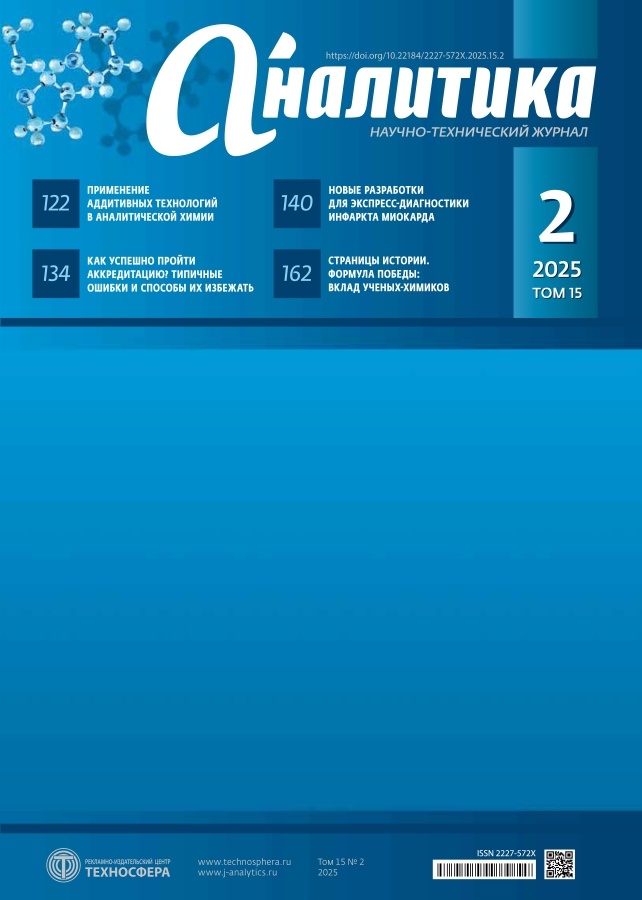Исследование пищевых красителей: методические подходы и текущее состояние проблемы
- Авторы: Пацовский А.П.1
-
Учреждения:
- АО «ГосНИИхиманалит»
- Выпуск: Том 15, № 2 (2025)
- Страницы: 156-161
- Раздел: Аналитика веществ и материалов
- URL: https://journals.eco-vector.com/2227-572X/article/view/685527
- DOI: https://doi.org/10.22184/2227-572X.2025.15.2.156.161
- ID: 685527
Цитировать
Полный текст
Аннотация
С притоком зарубежных продовольственных товаров на российский рынок остро встал вопрос о создании отечественной нормативной базы, регламентирующей физико-химические методы идентификации и определения синтетических красителей в пищевых продуктах. Несмотря на внедрение стандартизованных методик контроля синтетических красителей в напитках, карамели, пряностях, фруктовых консервах и замороженных десертах и возросшие возможности федеральных служб, осуществляющих надзор за поступлением в торговые точки некачественной фальсифицированной пищевой продукции, проблема остается актуальной. Обновленная нормативно-техническая база должна охватить все виды выпускаемых отечественных и ввозимых продовольственных товаров, учитывать современные тенденции развития аналитического приборостроения, востребованность и возможности нового оборудования для использования его потенциала в совершенствовании системы контроля качества пищевых продуктов.
Полный текст
Об авторах
Александр Петрович Пацовский
АО «ГосНИИхиманалит»
Автор, ответственный за переписку.
Email: patsovskiy_ap@mail.ru
кандидат технических наук, доцент, ведущий научный сотрудник
Россия, Санкт-ПетербургСписок литературы
- Бегунов А. А. Метрология. Методы, средства и методики аналитических измерений в пищевой и перерабатывающей промышленности. СПб: Гиорд, 2019. 640 с.
- Пацовский А. П. Исследование пищевых продуктов, на предмет наличия красителей не натурального происхождения. Биотехносфера, 2017; 1(49): 19–23.
- Лаптев А. Ю. и др. Адсорбция синтетических красителей в условиях капиллярного зонного электрофореза. Вестник Московского университета. Серия 2. Химия, 2021; 62(3): 230–237.
- Rudometova N. V. et al. Method of Isolation and Identification of Carthamin in Saf-Flower. Aplication’s Perspectives in Russian Food Products V International Safflower Conference, 23–27 July 2001. Williston, N.D., U.S.A., 2001. P. 309–313.
- Пацовский А. П. Современные достижения в области тонкослойной хроматографии. Мир измерений, 2013; 1: 36–40.
- Сигурдсон Г., Коллинз Т. М., Джусти М. М., Роббинс Р. Дж. Композиции красителей и способы их использования. Патент РФ № 2721836С2. 2020. 90 с.
- Касторных М. С. Товароведение и экспертиза пищевых жиров, молока и молочных продуктов. 3-е изд., доп. М.: Дашков и Ко, 2009. 326 с.
- Абраменко Л. И. Обнаружение синтетических пищевых красителей в йогуртах. Сб. материалов международной студенческой научной конференции Научный потенциал студенчества – развитию кооперативной науки. Белгород, 2010. C. 28–33.
- Брынских Г. Т. Качественное и количественное определение пищевых красителей в окрашенных газированных напитках. Ульяновский медико-биологический журнал, 2014; 4: 74–77.
- Аникина Н. С. Экспресс-тест для выявления синтетических красителей в винопродукции. Аналитика и контроль, 2021; 25(2): 126–133.
- Цюпко Т. Г., Коншина Д. Н., Коншин В. В. Способ определения синтетических красителей в вине. Патент РФ № 2825883С1. 2024. 7 с.
- Березкин В. Г. Двумерная электроосмотическая ТСХ при определении синтетических красителей и витаминов. Сорбционные и хроматографические процессы, 2009; 9(1): 43–50.
- Коренман Я. И. Экстракционное концентрирование и идентификация синтетических красителей в пищевых продуктах методом ТСХ. Заводская лаборатория. Диагностика материалов, 2010; 6: 16–18.
- Плешак Е. М. Экстракционно-фотометрическое определение синтетических пищевых красителей в жидких пищевых продуктах. Аналитика и контроль, 2020; 24(3): 186–194.
- Полянских Е. И. Результаты исследования содержания синтетических красителей в пищевой продукции, поступающей на рынок Республики Беларусь. Наука, питание и здоровье: сборник научных трудов III Международного конгресса (Минск, 24–25 июня 2021 г.): в 2 ч. Ч. 2. Минск: Белорусская наука, 2021. С. 465–469.
- Цимбалаев С. Р. Скрининг-метод выявления присутствия анионных синтетических и натуральных красителей в алкогольной продукции на основе ион-парного экстрагирования. Виноградарство и виноделие, 2020; 49: 255–257.
- Толоконцева Е. О. Количественное определение содержания пищевых красителей в напитках. Modern Science, 2021; 11–3: 40–44.
- Чаш-оол Н. Н. Сорбционно-спектроскопическое определение синтетических пищевых красителей с использованием модифицированных оксидов. Вестник Тувинского государственного университета, 2022; 2 (93).
- Шубина Е. Г. Определение содержания водорастворимых и жирорастворимых пищевых красителей в рыбной икре методом ВЭЖХ. Ученые записки Казанской государственной академии ветеринарной медицины им. Н. Э. Баумана, 2024; 259(3): 294–300.
- Жирнов Е. Хлеб наш поддельный. Деньги, 2009; 21: 53–59.
- Песенкова Я. А. Экспресс-анализатор синтетических пищевых красителей. Патент РФ № 229219U1. 2024. 9 с.
Дополнительные файлы






